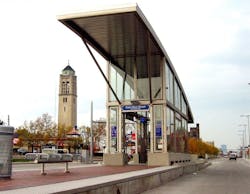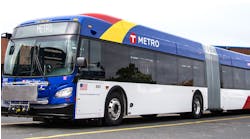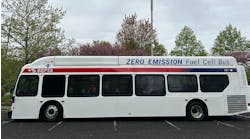NORTH OLMSTED, Ohio — North Olmsted boomed after World War II as a sprawling, low-density, automobile-oriented Cleveland suburb with housing subdivisions and the Great Northern Mall edging the I-480 freeway.
Now, after more than two decades into the 21st century, the western Cuyahoga County suburb is shaping up as the next frontier in a back-to-the-future movement to rebuild thinned-out parts of the region around densely developed transit corridors.
North Olmsted is also the latest example of how the Greater Cleveland Regional Transit Authority is playing a leading role in retrofitting a region designed for cars.
Last fall, RTA applied to the Federal Transit Administration for $560,000 to help fund a $700,000 project to plan a new bus rapid transit line on Lorain Road, extending 15.7 miles from North Olmsted through neighboring Fairview Park to Ohio City on Cleveland’s West Side.
The bus line would intersect with three stops on the RTA rail rapid transit Red Line, with connections to Tower City Center in downtown Cleveland.
If funded, the Lorain Road project would create the longest leg yet in an emerging hub-and-spokes network of enhanced bus lines that would complement the Red, Blue and Green lines of RTA’s rapid transit light rail system. If the federal grant isn’t approved, RTA will keep applying, said Mike Schipper, the agency’s deputy general manager.
The project is part of RTA’s larger effort to collaborate with Cleveland, Cuyahoga County and a growing number of suburbs on a vision to use the bus rapid transit lines, or BRT, to jumpstart dense, walkable, transit-oriented development across the county.
In North Olmsted, for example, RTA’s plan would dovetail with the city’s exploration of rezoning the Great Northern Mall to encourage construction of apartments on new streets that would bring life and economic activity to the mall’s often empty parking lot.
Max Upton, North Olmsted’s director of economic and community development, said that the mall, which lost its anchor tenant, Sears, in 2020, occupies roughly 139 acres, of which 75 acres are covered by parking and another 26 to 27 acres are accounted for by a ring road and interior streets.
“Only 25 or 30 acres of that entire amount is actually buildings,’’ he said, intimating that the land has a much higher potential.
Renderings by City Architecture, a consultant hired by North Olmsted, show how the city could build blocks of four-story apartment buildings and parklike, tree-lined public spaces along new streets installed on the acres occupied by the mall.
North Olmsted could also consider rezoning lifeless portions of Lorain Road where pedestrians feel unsafe to encourage transit-oriented development, or TOD, around the proposed bus rapid transit line.
The visions coming from North Olmsted are based on a chicken-egg logic. If the city zones for density around more robust transit service, both it and RTA would benefit from ensuing development that would otherwise not occur.
The trick is to coordinate the city’s land uses with the ridership needed to support transit, and vice versa.
“For us it’s existential,’’ Upton said of such thinking. “People know North Olmsted as a fantastic community with solid housing stock and great a school system and access to top notch amenities. But if you’re not evolving, you’re dying.’’
Rebuilding from within
North Olmsted’s story is part of an emerging regional response to decades of planning dominated largely by the automobile. Since the construction of the interstate highways more than 60 years ago, Cuyahoga County filled up largely with spread-out housing subdivisions, malls and strip shopping centers as the urban core emptied out.
Declines in RTA ridership coincided with the suburban expansion. Then, just as the agency completed a new 10-year strategic plan in 2020, the COVID pandemic and the rise of remote working further depressed ridership, which hasn’t yet rebounded to 2019 levels.
Concerns over safety and quality of service continue to dog the agency, as the 2020 Strategic Plan acknowledges. But its planning and capital spending show it’s working on improvements and intends to play a significant role in Cuyahoga County’s future.
RTA’s biggest project over the past four years has been to tap money from the bipartisan infrastructure bill and other state and federal sources to replace aging heavy and light rail cars on its Red and Blue and Green rapid transit lines by 2028.
RTA has raised $355.3 million of the $393 million needed to pay for the rail cars, and expects to close the remaining gap, Schipper said. The agency is also investing in rebuilding its East 79th Street Blue and Green line rapid transit station in Cleveland. And it’s reconfiguring the Warrensville station area on the Blue Line in Shaker Heights.
Planning for growth
As for buses, RTA’s 2020 Strategic Plan called for improving the frequency of service on what it calls Priority Corridors radiating out through from Cuyahoga County’s urban core. The routes include West 25th Street, Broadway Avenue, and Lorain Avenue (which goes by Lorain Road in North Olmsted and neighboring Fairview Park).
The plan also identified those and other corridors as ripe for new bus rapid transit lines. With special lanes for high-speed boarding and priority flow at traffic signals, BRT lines are cheaper and easier to build than new streetcar or light rail lines.
In Cuyahoga County, the new lines could repurpose onetime routes used by streetcars and interurban rail lines, which were removed starting in the 1930s as the region shifted to automobile-oriented planning.
“They’re poised for a new future of multi-modalism,’’ Cuyahoga County Executive Chris Ronayne, a former Cleveland planning director, said of the old commuting routes. “They’re all ripe for a reset.’’
The new development encouraged by the BRT lines, in turn, could reverse the decades-old donut pattern created by sprawl. It would create a win-win virtuous cycle by boosting the county’s shrinking tax base, attracting new residents and increasing RTA ridership.
Expanding a network
There’s reason to believe the strategy will work. Growing numbers of new apartment buildings in Cleveland’s high-demand neighborhoods, and residential conversions of office buildings downtown signal a back-to-the-city trend.
RTA has contributed to the growth. The agency’s Euclid Avenue HealthLine, a four-mile, $200 million bus rapid transit project completed in 2008 between Public Square and University Circle in Cleveland, helped leverage more than $9 billion in economic development over 10 years around the Cleveland Clinic and the city’s once desolate Midtown neighborhood, according to data compiled by RTA.
The transit agency is building on that example by planning its network of bus rapid transit lines one leg at a time.
RTA followed up on the HealthLine in 2014 with a four-mile bus rapid transit route on Clifton Boulevard on Cleveland’s West Side that was less costly and elaborate than the HealthLine. Named for Cleveland State University, the line consolidates routes for No. 55 buses running from Rocky River and Lakewood to CSU’s downtown campus.
This month, RTA is starting an 18-month design process for a more robust BRT line along West 25th Street from Detroit Avenue in Ohio City south to the MetroHealth campus and beyond to the Cleveland Metroparks Zoo.
RTA has raised $30 million toward the estimated $50 million cost of the project, including $12 million from the Ohio Department of Transportation and a $10 million local match.
RTA also announced that it just received $432,000 from the Federal Transit Administration to plan a four-mile bus rapid transit route on Broadway Avenue in Cleveland. The agency is contributing another $108,000 as the local match for the $540,000 planning process.
The Broadway route will extend from the East 34th Street Red Line Rapid Transit rail station near downtown southeast through the Slavic Village neighborhood to the edge of Garfield Heights at the Turney/Ella bus loop.
The agency plans to start an 18-month planning process for the Broadway project by next year, with two years of construction completed by 2030.
Cleveland City Planning Director Joyce Pan Huang said she’s pleased to see Slavic Village in line for such an investment after having suffered high levels of housing abandonment and decay during the 2008-09 recession and subprime mortgage crisis.
RTA is trying to tap the power of transit-oriented development on its own by offering excess property along some of its routes to developers.
It now has two active projects underway in collaboration with the developer Flaherty and Collins at its West Park and West Boulevard stations, and is refining a third deal along Columbus Road with AJAPPR LLC, whose managing partner is Cleveland developer Ari Maron
RTA is seeking developers for another six sites that it considers excess and available for development.
City, county initiatives
Cleveland and Cuyahoga County, meanwhile, have stepped up efforts to support transit-oriented development.
In April, county planners will release a model zoning code for TOD that suburbs could tailor to their own needs. The model code follows a yearlong study showing how 85 square miles of thinly-developed land along 22 corridors in Cleveland and 25 suburbs could become more transit- and pedestrian-friendly.
Cleveland is shifting its design DNA to help it achieve Mayor Justin Bibb’s goal of making it a “15-minute city,’’ in which most needs for daily living can be met within a short walk from home.
On March 15, the Cleveland City Planning Commission recommended that City Council should approve a pilot program to employ “form-based zoning’' in three neighborhoods to encourage mixed-use developments, pedestrian-friendly streets, and gentle transitions to residential areas.
The planning commission also established “transportation demand management standards’' for new development within the city portion of the corridors identified by county planners for transit-oriented development.
The standards would waive parking minimums, which could make new housing more affordable, and stimulate transit ridership.
Suburban buy-in
Cuyahoga County has a long way to go to reach higher housing densities along transit routes. Data compiled by planners showed that only 5% of the land along the 22 corridors they studied is now zoned for transit-oriented development.
Cleveland planners found that none of the census tracts within its portion of the corridors identified by the county meet the often-cited threshold of 20 dwelling units per needed to support a healthy transit system.
“That’s a scary statistic,’’ said India Birdsong Terry, RTA’s CEO and general manager. “We cannot continue development in the vein of the current zoning and expect a different result.’’
Birdsong Terry said the regional uptake of transit-oriented development “is happening at a tolerable clip,’’ but she’d like to see a faster pace.
Some Cleveland suburbs are beginning to embrace the new ideas. Garfield Heights started working last year with county planners on a project to look at rezoning 2.25 miles of Turney Road from Ella Avenue south to I-480 to encourage transit-oriented development. RTA’s Schipper said the agency might consider extending its Broadway BRT study to include an extension on Turney Road.
In February, Cleveland Heights City Council updated its zoning code to require transit-oriented design in commercial districts across the city. City Planning Director Eric Zamft applauded RTA’s advocacy for such changes.
“They’re realizing its good for business to have density around transit stops and it makes their system work better,’’ he said.
Politically conservative critics deride transit-oriented planning as a top-down plot to curtail individual liberty. But transit advocates say it makes sense to give people the freedom to avoid the expense of owning a car.
“There is demand for public transit, walking and biking,’’ said Grace Gallucci, executive director of the Northeast Ohio Areawide Coordinating Agency, which has long supported the idea of transit-oriented development. “I don’t think we’re presenting this as a top-down, planner-driven initiative. This is in fact bottom-up.’’
In North Olmsted, Upton said the city’s emerging vision for Great Northern Mall and Lorain Road is informed by a survey of 1,700 residents who support the city’s new plans.
“The overwhelming majority wanted to think about Lorain Road as a more vibrant place,’’ he said. “What it comes down to is quality of place, for me, and I think for our residents.”
©2024 Advance Local Media LLC. Visit cleveland.com. Distributed by Tribune Content Agency, LLC.


